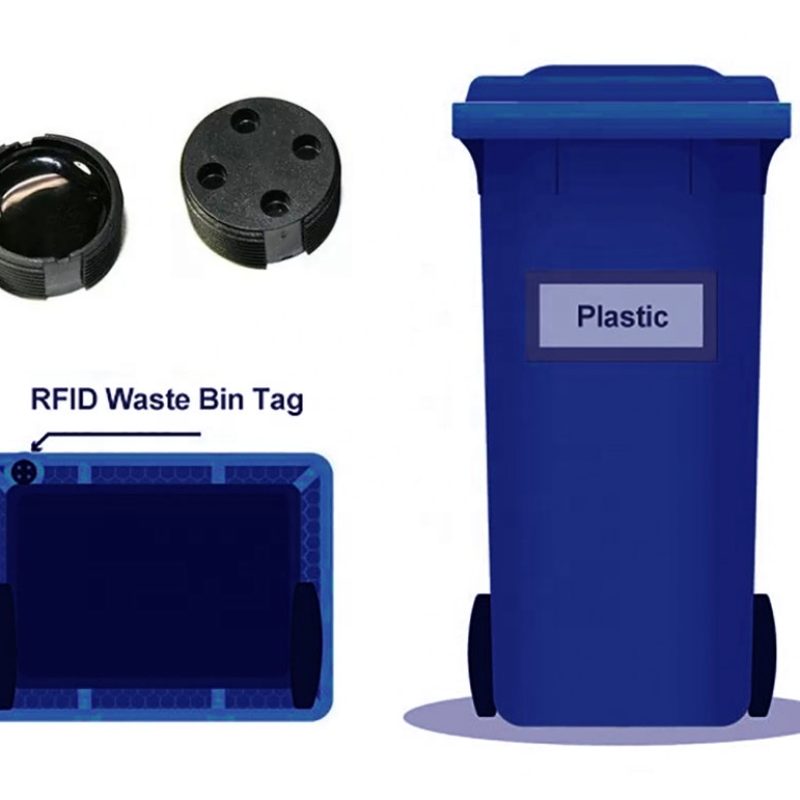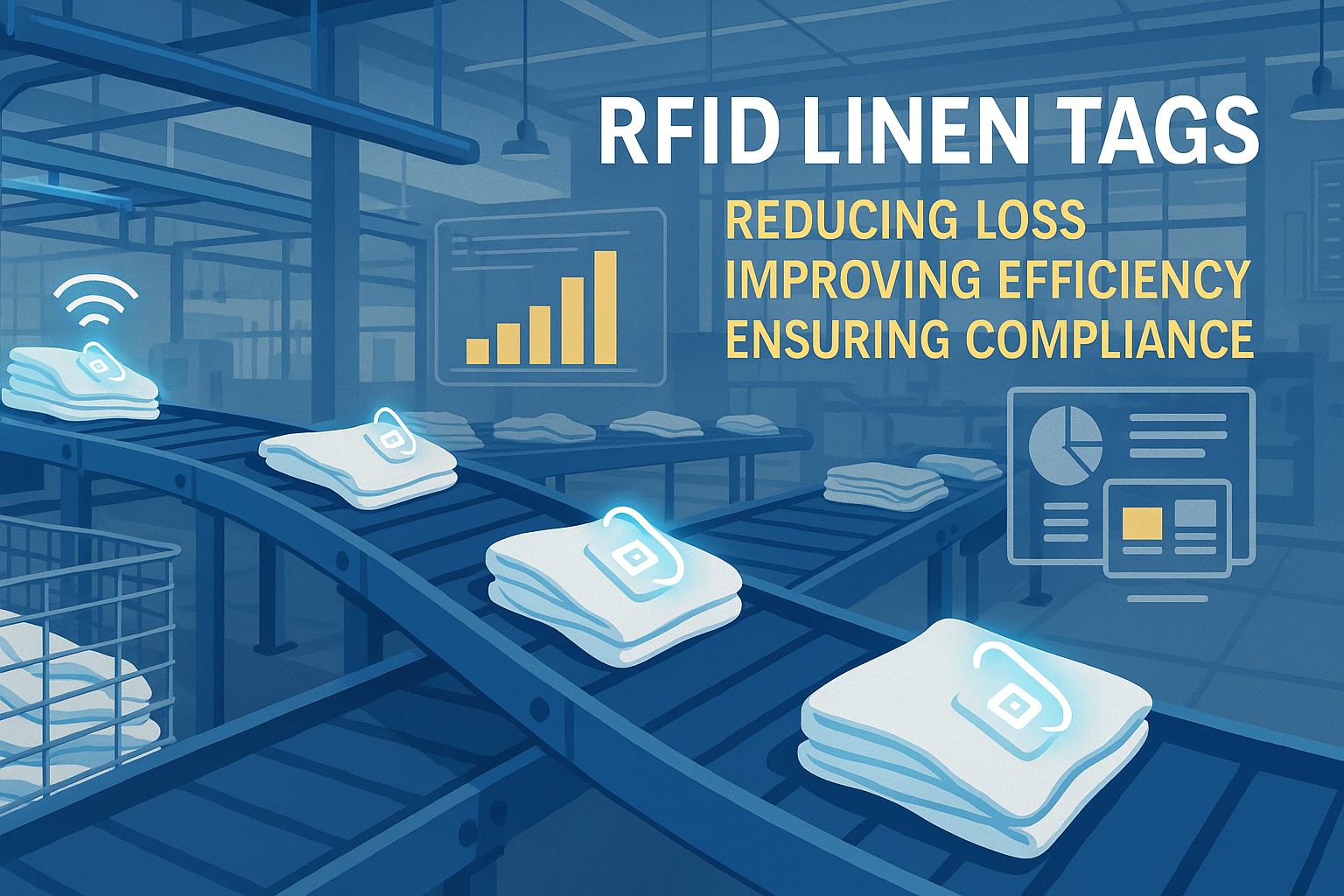
RFID廃棄物管理とは何か
目次
RFID廃棄物管理入門
“RFID(Radio-Frequency Identification)は、電波を用いて物品を自動的に識別・追跡する技術である。廃棄物システムに適用することで、自治体や企業は収集から輸送、処分に至る廃棄物の全行程を追跡可能となる。スマートシティインフラにおける最も有望な革新技術の一つであり、廃棄物収集の効率化、透明性向上、環境配慮の実現に貢献している。.
RFID廃棄物管理とは何か?
RFID廃棄物管理では、ごみ箱、ごみ袋、またはごみ収集カートに小型のRFIDタグを埋め込みます。これらのタグは、収集トラックや分別施設に設置されたRFIDリーダーによって読み取られます。各読み取りでは、時間、場所、ごみ箱ID、さらには重量などのデータが記録されます。.
各ごみ箱にデジタルIDカードを付与するようなものです。収集車が通過すると、システムはどのごみ箱がいつ、どの車両によって処理されたかを正確に把握します。これにより、収集プロセスの完全なトレーサビリティと自動化が実現します。.
例えば、都市や民間事業者は現在、 RFIDごみ箱タグ 家庭ごみ容器に設置し、収集確認、収集漏れ削減、および請求の自動化を実現する。.

RFID廃棄物管理システムの仕組み
すべてのRFID廃棄物管理システムには、主に3つの構成要素が含まれます:
- RFID タグ: 廃棄物容器やコンテナに設置された小型電子チップ。.
- RFIDリーダー: 収集車や収集場所に設置され、タグをスキャンする装置。.
- バックエンドソフトウェア: データを収集・分析する管理プラットフォーム。.
トラックが通過すると、リーダーが近くのタグを検知し、各コンテナの位置、時間、回収確認といったデータを記録します。この情報はデータベースに送信され、オペレーターはダッシュボード、パフォーマンス指標、ルート履歴を確認できます。.
より高度なシステムでは、RFIDごみ箱タグが充填レベルや重量を測定するセンサーと統合されています。GPSとルート最適化ソフトウェアと組み合わせることで、RFIDは都市が廃棄物収集を精密に効率化するのに役立ちます。.
廃棄物管理におけるRFIDの利点と活用事例
都市や企業がRFID廃棄物管理を導入する理由は以下の通りです:
- 経路最適化: トラックは空のコンテナを素通りし、燃料と時間を節約する。.
- 正確な請求 住民が実際の廃棄物量に基づいて課金される従量制ごみ処理制度をサポートします。.
- より良い説明責任: 各ごみ収集サービスは記録され、苦情や収集漏れを減らします。.
- 強化されたリサイクル: RFIDデータは廃棄物の種類を識別するのに役立ち、分別とリサイクル率の向上に貢献します。.
例としては、自治体がサービス完了の確認にRFIDごみ箱タグを利用することや、産業施設が有害廃棄物の追跡にRFIDを活用し、規制順守とトレーサビリティを確保することが挙げられる。.
実例とケーススタディ
世界中の都市では、すでにRFID技術を用いた廃棄物管理システムを導入し、近代化を進めている。そしてその成果は明確に測定可能である。.
アムステルダム
アムステルダム市は全家庭のごみ箱にRFIDタグを設置した。その結果は明らかだった:
- 15% 収集漏れが減少
- リアルタイムデータを活用した効率化された収集ルート
- 燃料消費量と運転時間の大幅な削減
ソウル
ソウルの従量制食品廃棄物プログラムでは、RFIDごみ箱タグを用いて廃棄物を追跡する。住民はスマートごみ箱でRFIDカードをタップすると、システムが廃棄物を計量し、それに応じて課金する。このシステムにより、一部の地区では食品廃棄物が301トン以上削減されたと報告されている。.
民間運送業者
民間廃棄物管理会社もRFID廃棄物管理技術を活用して以下の目的を達成しています:
- 商用ピックアップトラックをリアルタイムで追跡する
- 請求の自動化
- 顧客が気付く前にサービス上の問題を特定する
RFIDとバーコードによるごみ箱追跡システムの比較
RFIDとバーコードはどちらも廃棄物容器の追跡に使用されますが、性能、自動化、耐久性において技術的に大きく異なります。以下の表は、現代の廃棄物処理業務に関連する主要分野における両手法の比較を示しています。.
| 特徴 | RFIDごみ箱追跡システム | バーコード式ごみ箱追跡システム |
|---|---|---|
| スキャン方法 | 電波を使用するため、見通し距離が不要です。リーダーは数メートル離れた場所からタグを自動的に検出できます。. | 直接視界が必要です。作業員は各ラベルを手動でスキャンする必要があります。. |
| スピードと効率 | 高 — 複数のビンを同時にスキャン可能。トラックが移動中でも対応可能。. | 低 — 一度にスキャンできるのは1つのゴミ箱のみのため、収集速度が遅くなる。. |
| 耐久性 | RFIDごみ箱タグは汚れ、湿気、損傷に強い。. | バーコードは簡単に色あせたり、汚れや傷で覆われてしまう。. |
| データ容量 | ビンID、所有者、重量、履歴などの詳細データを保存できます。. | 単純な数字または英数字のコードに限定される。. |
| 自動化の可能性 | 完全自動化 — IoTセンサー、GPS、ルート最適化と統合。. | 手動方式 — スキャンと記録を人間のオペレーターに依存する。. |
| 初期費用 | 初期費用は高い(タグとリーダー)が、自動化による長期的な投資対効果が見込める。. | 初期費用は低いが、継続的な人件費とエラーの発生率が高い。. |
| 最適な用途 | スマートシティ、産業施設、そして自動化を目指す民間運送業者。. | 基本的な識別機能が必要な小規模な運用や低予算システム。. |
要約すると、RFID廃棄物管理は拡張性のある自動化ソリューションを提供する一方、バーコード追跡は低コストの入門レベルオプションのままである。長期的な効率性を求める都市や組織にとって、RFIDごみ箱タグはより賢明な投資である。.
産業廃棄物流におけるRFID廃棄物管理
RFID廃棄物管理は産業廃棄物の追跡方法も変革している。製造業、建設業、医療などの分野では、規制順守とトレーサビリティは必須要件である。.
RFIDごみ箱タグを使用することで、企業は廃棄物コンテナの発生から輸送、最終処分に至るまでの全移動を記録できます。タグはタイムスタンプ、取扱者、経路を捕捉し、完全な管理の連鎖(チェーン・オブ・カストディ)の可視性を確保します。.
例えば病院では、バイオハザード容器の追跡にRFIDを活用している。自動車工場では、スクラップ金属や化学廃棄物の監視に利用している。このデータはコンプライアンスの向上に寄与するだけでなく、資材の流れや廃棄プロセスにおける非効率性を特定する役割も果たす。.
厳格な監査やサステナビリティ報告に直面する業界において、RFID廃棄物管理は信頼性の高い改ざん防止の文書化とリアルタイムの運用インサイトを提供します。.
RFID廃棄物管理は収集コストを削減できるか?
もちろんです。RFID廃棄物管理に組み込まれた自動化は、直接コスト削減につながります。.
どのゴミ箱が満杯かリアルタイムで把握できるため、トラックは不要な停車地を省略可能——燃料消費量、労働時間、車両の摩耗を削減します。アムステルダムなどの都市では、RFIDゴミ箱タグを導入後、収集漏れや業務効率の低下が大幅に減少したと報告されています。.
民間収集業者にもメリットがある:自動化された収集確認により紛争や書類作業が最小限に抑えられ、ルート最適化ソフトウェアが総走行距離を削減する。時間の経過とともに収集されたデータは、収集頻度やごみ箱の配置を調整し効率を最大化する、より賢い計画立案を可能にする。.
RFIDハードウェアへの初期投資はバーコードよりも高額ですが、ほとんどの事業者は物流、燃料、管理業務のコスト削減により、1年から3年以内に投資回収を達成しています。.
課題、落とし穴、および考慮事項
最高のRFID廃棄物管理システムでさえ、障壁がある:
- コスト:タグ、リーダー、および統合に関する初期費用。.
- 技術的要因:読み取り範囲は、容器の材質や環境条件によって影響を受ける可能性があります。.
- データプライバシー:ごみ箱IDと世帯の紐付けには、慎重なデータ保護が必要です。.
- 持続可能性:RFIDチップには電子部品が含まれており、責任を持ってリサイクルする必要があります。.
- トレーニング:従業員とITチームは、新システムに関するオリエンテーションが必要です。.
パイロット運用を最初に実施することが、スケールアップ前にハードウェアとデータ処理を微調整する最善の方法である。.
RFID廃棄物管理の実施手順
RFIDを活用した廃棄物管理を検討する自治体や企業向けの明確なロードマップは以下の通りです:
- 目標を設定する:例:回収漏れを20%削減、リサイクル率を15%向上。.
- 現行システムの監査:使用中のごみ箱の種類、収集ルート、およびデジタルツールを特定する。.
- ハードウェアとソフトウェアの選択:パッシブ型またはアクティブ型RFIDビンタグと互換性のあるリーダーを選択してください。.
- パイロットを実施する:1つの地区または施設で試験的に実施する。.
- スケールアップ:カバレッジを拡大し、課金および分析システムと連携する。.
- 監視と最適化:RFIDデータを継続的に活用し、業務を改善する。.
労働者、住民、および関係者と早期に関与することで、導入が円滑に進み、コミュニケーションが明確になります。.
今後の動向と今後の展望
RFID廃棄物管理の未来は、スマート技術とのより深い統合にある:
- IoTセンサー: RFIDとレベルまたは重量センサーを組み合わせてリアルタイム監視を実現する。.
- AIとアナリティクス: 経路を予測し、異常を自動的に検出する。.
- 循環型経済の追跡: 収集からリサイクルまでの資材を追跡する。.
- 環境に優しいタグ: リサイクル可能または生分解性のRFIDごみ箱タグの開発。.
- 世界的な普及: 新興市場がRFIDをスマートシティ構想に統合している。.
よくある質問
なぜ都市は廃棄物管理においてバーコードからRFIDへ移行しているのか?
RFIDは手動スキャンを不要にするためです。自動コンテナ検出、リアルタイム追跡、ルート最適化ソフトウェアとの連携を可能にします。これらはバーコードでは実現できない機能です。.
RFIDごみ箱タグは、あらゆる種類のごみ容器で機能しますか?
はい。RFIDごみ箱タグは様々な素材(ナイロン、ABS樹脂、エポキシ樹脂)で製造され、高温、雨、機械的ストレスに耐えるよう設計されています。金属製ごみ箱や地下設置型ごみ箱向けの専用モデルも存在します。.
RFIDとバーコードは併用できますか?
それらは可能だ——一部のハイブリッドシステムでは、RFIDが主要なデータ収集を担う一方で、バーコードをバックアップや視覚的参照として使用している。しかし、現代のほとんどのRFID廃棄物管理ソリューションは、速度と自動化のために完全にRFIDに依存している。.
RFIDごみ箱タグは高価ですか?
個々のタグは比較的低コストである。主な投資はリーダーとシステム統合に必要となるが、人件費と燃料費の削減による運用コストの節約が、これらの費用をすぐに相殺する。.
RFIDデータは安全ですか?
はい。現代のRFIDシステムでは、タグとリーダー間の通信に暗号化が使用されており、機密性の高い収集データや請求データが確実に保護されます。.
結論
RFID廃棄物管理は、廃棄物の収集と監視の方法を変革し、よりスマートで、よりクリーンで、より説明責任のあるものへと進化させています。.
RFIDごみ箱タグ、リーダー、分析ツールを組み合わせることで、自治体や企業はコスト削減、サービス信頼性の向上、持続可能性目標の強化を実現できます。単なるごみ箱へのタグ付けではなく、廃棄物業界のための接続された効率的なエコシステムを構築することなのです。.
組織が回収コストの削減、コンプライアンス要件の達成、データ駆動型運営への移行を目指すなら、まずは小規模なRFIDパイロットから始め、その効果を測定しましょう。1つの回収容器、1つの回収ルート、1つの都市から段階的に進めるのです。.

レイ・ジョウ
この記事は、RFID技術の専門家であり、10年以上の業界経験を持つRay Zhouが執筆した。
コメント
人気商品

RFID廃棄物管理とは何か
想像してみてください。街中のゴミ箱がすべて「話す」街を――文字通りではなく――小さなチップを通じて、満杯になった時、空になった時、そしてどこへ運ばれたかをシステムに伝えるのです。それが今日のRFID廃棄物管理の仕組みです。.

ボルトシールとその用途とは?| 完全ガイド
世界的な貿易と物流において、ボルトシールは貨物のセキュリティとコンプライアンスを確保する上で重要な役割を果たしています。これらの小型で強力なデバイスは、タンパーエビデント機構で輸送コンテナ、トレーラー、貨物ドアをロックするように設計されています。

RFIDカードプロテクターとは?メリット、使用例、購入ガイド
RFID(Radio Frequency Identification)テクノロジーは、クレジットカード、IDバッジ、定期券、ホテルのルームキーなど、あらゆるところに浸透している。RFIDはスピードと利便性を提供する一方で、「スキミング」と呼ばれる新たなデジタル窃盗への扉も開いている。そこでRFIDカードプロテクターの出番です。

イベント用RFIDリストバンド:主催者向け一括購入ガイド
イベント用RFIDリストバンドは、コンサート、フェスティバル、スポーツ会場などで、迅速な入場、不正防止、キャッシュレス決済を必要とする主催者にとって、最適なソリューションになりつつあります。紙のチケットやQRコードとは異なり、これらのスマートリストバンドは埋め込みチップを使用し、アクセスを合理化し、取引を安全にし、ゲストの体験を向上させます。

フロントガラス上のRFIDタグが車両入退場管理と料金システムを改善する方法
ペースの速い今日の世界では、車両識別は迅速、安全、非接触である必要があります。フロントガラス上のRFIDタグは、まさにそれを提供します-車両を止めることなく、料金徴収、駐車、ゲートアクセスを管理する信頼性の高い方法です。

業務用ランドリーにおけるRFIDリネンタグの利点
病院やホテル、大規模なランドリーサービスでのランドリー管理は大仕事だ。毎日、何千枚ものシーツ、タオル、ユニフォームが洗濯され、仕分けされ、送り返されます。しかし、リネンの紛失、仕分けのミス、手作業による計数などの問題は、企業に多大な損失をもたらします。例えば、中規模のホテルでは、リネンの紛失によって毎年$200,000以上の損失が発生します。
そこでRFIDリネンタグの出番だ。




